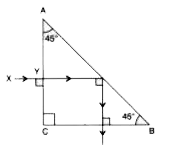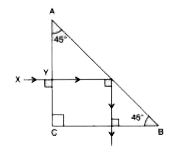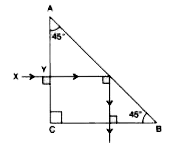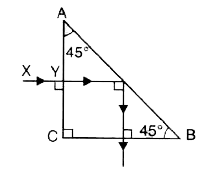A ray of light XY passes through a right angled isosceles prism as shown below.
Name the instrument where this action of prism is put into use.
Periscope
Topper's Solved these Questions
Similar Questions
A ray of light XY passes through a right angled isosceles prism as shown alongside.
Name the instrument where this action of prism is put into use.

View SolutionA ray of light XY passes through a right angled isosceles prism as shown below:

Which prism surface will behave as a mirror ?
View SolutionA ray of light XY passes through a right angled isosceles prism as shown below.

What is the angle through which the incident ray deviates and emerges out of the prism?
View SolutionA ray of light XY passes through a right angled isosceles prism as shown alongside.
Which prism surface will behave as a mirror ?

View SolutionA ray of light XY passes through a right angled isosceles prism as shown alongside.
What is the angle through which the incident ray deviates and emerges out of the prism ?

View Solution
A ray of light XY passes through a right angled isosceles prism as shown alongside Figure.
(a) What is the angle through which the incident ray deviates and emerges out of the prism?
9b) Name the instrument where this action of prism is put into use.
(c) Which prism surface will behave as a mirror ?
View SolutionA ray of light PQ is incident normally on the hypotenuse of a right angled prism ABC as shown in the diagram.

Name an instrument where this action of the prism is used.
View SolutionA ray of light PQ is incident normally on the hypotenuse of a right angled prism ABC as shown in the diagram given below:
Name an instrument where this action of the prism is used.
View SolutionDraw a diagram of a right angled isoscels prism which is used to make an inverted image erect.
View SolutionShow with the aid of a ray diagram, how a right angled isosceles prism can be used to invert the rays. (a) How sould the rays fall on the prism ?
(b) Which phenomenon is responsible for this action of prism? (c) What is the nature of the image in relation to the object ?
View Solution
